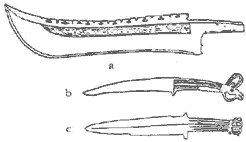
The Cambridge History of Ancient China:
From the Origins of Civilization to 221BC
© Cambridge University Press 1999, ISBN 9780521470308
Archaeology. The Northern Zone (South Siberia)
by Robert Bagley, Princeton University
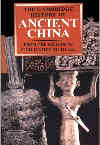
Links
Posting Introduction
A brief review of the Kurgan people culture see on page 1 “Zhou Culture”. This page reviews in modern Chinese terms the archeological expression of the Kurgan Culture in the aspect of the Zhou Culture. A follow-up explanation of the origin of Eurasian metallurgy developed by E.N. Chernykh, is posted after the citation from “The Cambridge History of Ancient China”. Though the review does not define specifically the timing of the Hunnic arrival, the Erlitou objects of ca. 16th c. BC already show a presence of the Karasuk metalwork in the Shang's Yin period.
* * *.
The posting's notes and explanations, added to the text of the author and not noted specially, are shown in (blue italics) in parentheses and in blue boxes. With minor exceptions where footnote explanations are a part of the narrative, the footnotes, which mostly dwell on the sources, are not posted. Square brackets in the text replace omitted Chinese transcriptions.
Princeton University
Shang archaeology (in China, 1600 - 1145 BC)
Early Bronze Age
Archaeology. The Northern Zone (South Siberia)
The Northern Zone (South Siberia)
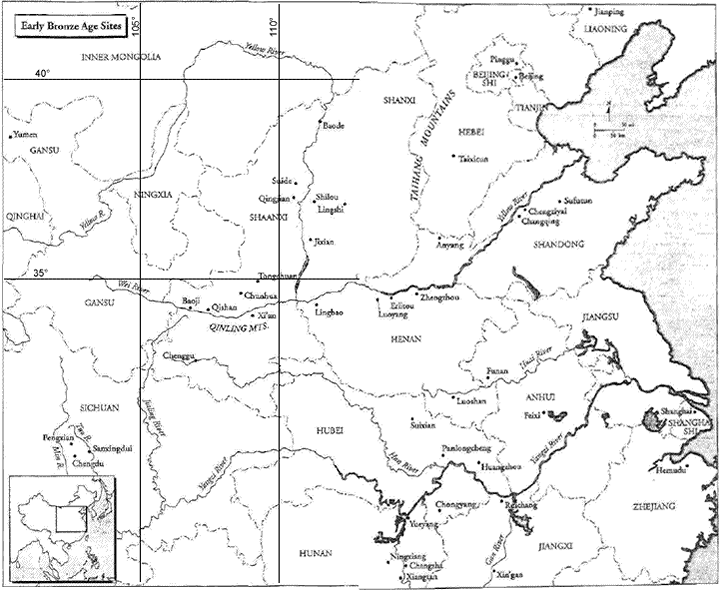
Part forest, part desert, mostly grassland, the Northern Zone (looking from South China) lies along the northern borders of modern China, stretching from Xinjiang and Gansu in the west to Jilin in the east and including parts of Inner Mongolia and Liaoning, along with much of Hebei, Shanxi, and northern Shaanxi. In the first millennium BC increased dependence on animal herding gave rise to societies of pastoral nomads in this region. 160 Already in the last few centuries of the second millennium, however, the Northern Zone was home to cultures recognizably distinct from the civilization of the middle Yellow River valley. In the material record this distinctiveness takes the form of an inventory of weapons and other small bronzes sometimes collectively referred to as the Northern Complex.
The bronzes of the Northern Complex are interesting for several reasons. First, although the various types cannot be traced to origins at any single place or date (some probably arose in the Northern Zone itself, others in Siberia), their affiliations far to the north and west establish the Northern Zone as the home of a metal industry that originated outside China, independent of the Erligang tradition. 161 Second, the widespread appearance of this inventory on the northern frontier of China seems to coincide with a southward retreat of the Erligang culture. In other words, at the northern limit of its distribution the Erligang culture is succeeded in the archaeological record by the Northern Complex. Lin Yun takes this to signify the arrival of new people and points to the gold ornaments in northern finds as markers of a distinct ethnic group. 162 No doubt the proximity of these people has something to do with the appearance at Anyang around 1200 BC of the chariot and other northern artifacts, including knives, mirrors, and bow-shaped objects like those found in Fu Hao's tomb (Fig. 3.25). 163 Borrowing in the opposite direction is attested by bronze vessels found in the Northern Zone, most often in Shaanxi and Shanxi.
| Figure 3.25. Bronzes of northern style, from Fu Hao's tomb. (a) Knife. (b) Minors. (c) Bow-shaped object | Figure 3 39 Objects from various finds at Shilou, Shanxi. (a) Gold earrings with turquoise beads. (b) Bronze arc (head ornament?) (Hunnic diadem). (c) Baattle axe with tubular shaft hole. (d) Wand or spatula. (g) Ladle. (f) Bell-shaped rattle. (g) Boat shaped vessel | Figure 3.36. Axes. Same scale, (a) Axe of the type yue. (b) Axe of the type ge. (c) Axe with tubular socket |
|---|---|---|
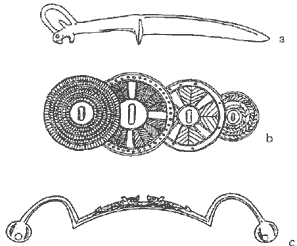 |
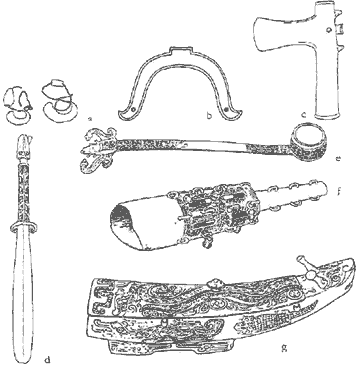 |
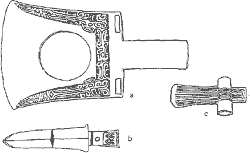 |
The bronzes of the Northern Complex are distinctive as types and distinctive also in decoration. Characteristic features are simple decorative patterns of striae and zigzags, loops or buttons for suspension, and terminals in the form of rattles or naturalistic animal heads. The types include weapons, mirrors (Fig. 3.25b), bow-shaped objects (Fig. 3.25c), and a variety of wands, spatulas, spoons, and ladles (Fig. 3.39d-e). Mirrors have been found most often in Gansu and Qinghai, at the far western end of the Northern Zone, but occasionally also in Inner Mongolia and Liaoning. Weapons form the largest category and the one whose affiliations reach farthest into Siberia. Typical items are battle-axes with tubular sockets (Figs. 3.36, 3.39c), knives with integrally cast handles (Fig. 3.37b), and daggers, that is, double-edged stabbing blades (Fig. 3.37c). Related knives and daggers occur in the late- second-millennium Karasuk culture of the Minusinsk Basin, and the battle-axes have a long history in Siberia, south Russia, and beyond (The gentle “beyond” is Central Europe, Balkans, Caucasus, Middle Asia, NearEast, into Scottland). 164
16l Chernykh (Ancient Metallurgy in the USSR, chapter: 9) treats the Northern Zone as the southeastern edge of his “General Asian Metal Working Province”
(“Common Asian” ? i.e. Steppe Belt and vicinities?), an archeological
entity defined by an assemblage whose distribution extends from Sayano-Altai and the
Minusinsk Basin of the middle Yenisei to the northern and northwestern frontiers of China.
164 Chtrnykh believes that socketed axes were invented in the fourth millennium in eastern
Europe or the Caucasus (Ancient Metallurgy in the USSR, pp. 300-301)
(Quite consistent with Kurgan Culture spread with horse
husbandry from Sredni Stog to Altai, and from Altai to Huanhe and Amur, and back to
Middle Asia, Southeastern Europe, Near East, and Balkans).
223
When these weapons occur at Anyang they are instantly recognizable as intrusive, for
the native tradition had no daggers, and its knives and axes were quite different. Anyang
knives have broad curved blades with short stems for mounting in a separate handle (Fig.
3.37a); northern knives have blades cast in one piece with their handles (Fig. 3.37b).
The axes native to China have flat tangs for hafting, whether the blade is broad (Fig.
3.36a) or pointed (Fig. 3.36b: the ge is an axe with a pointed blade); northern axes,
made in great variety, were hafted through shaft rings or tubular shaft holes (Figs.
3.36c, 3.39c). The two hafting methods are so different as to make it tempting to suppose
that all shaft-hole tools and weapons in China depend ultimately on northern prototypes.
Loehr long ago advanced typological arguments in favor of a Siberian origin, pointing out
that shaft holes,
ubiquitous in western Siberia, are a metalworker's invention, while all the blade types
indisputably native to China (because their distribution coincides with that of bronze
vessels) have flat tangs for hafting and thus are allied in principle with older stone
tools. 165
224
His argument applied to socketed implements as well, but socketed spearheads and celts (adze) occur in considerable variety at Panlongcheng and Xin'gan; if these were northern imports, they were naturalized early. Some northern borrowings had only a short life in China: ge blades made with shaft rings rather than flat tangs must have been inspired by the hafting method preferred in the Northern Zone (Siberia and beyond), but they were an experiment that had lost favor by early Zhou. By contrast ring-handled knives like the one unearthed at Erlitou (Fig. 3.12d) were a permanent acquisition. Fu Hao's tomb contained ten examples, and in the Zhou period this standard northern type completely superseded the native stemmed type.
Distributed over a vast area, the bronzes of the Northern Complex were the common property of otherwise diverse societies that ranged from forest dwellers heavily dependent on hunting in the east to societies more dependent on farming in the west.
Slight differences in the metal inventory suggest a broad division along the line of the Taihang Mountains [] (the Shanxi-Hebei border) l66 The division is clearest in the forms of certain ornaments. East of the mountains these include gold armlets and funnel-shaped earrings. 167 West of the mountains, on the loess plateau of northern Shanxi and Shaanxi, gold earrings take the form of flat spirals, often combined with turquoise beads, and they are sometimes found with gold or bronze arcs, perhaps ornaments for the head (Fig. 3.39a-b). The region west of the mountains has yielded a particular abundance of finds. Bronze vessels are more common here than elsewhere in the Northern Zone, and it therefore seems likely that this was the region most intimately in contact with Anyang and the Wei valley (the closest parallels to the vessels come from the Wei valley). But bronze finds in the Northern Zone have seldom been accompanied by any indication of context beyond occasional skeletal remains, and presently available information gives no clear picture of the inhabitants (Tunguses and Mongols had drastically different funeral custom from the Kurgan Culture steppe horse husbandry people. Supplying a deceased with prime necessities for a travel to the other world is a part of the religiuos etiology unseparable from the Kurgan Culture; the kurgans themselves were a part of that system of beliefs, they were a piled range or pasture needed on the road for horse transportation. Food containers, tools and weaponry, and transportation buried with the deceased to equip them for travel are the hallmarks of the Kurgan Culture).
Graves at three places in Shanxi will suggest the complexity of the archaeological picture. A small grave at Jixian [] contained four bronzes: a battle-axe and a rattle-pommel dagger on either side of the occupant's head and two large spoons next to the left hand (Fig. 3.38) 168 There is no sign here of contact with the Anyang culture. By contrast two large graves farther north at Lingshi [] contained a very few northern items alongside a rich array of Anyang-style vessels, and the graves themselves had such familiar features as yaokeng with sacrificed dogs. 169 Here the northern items look like intrusions in burials no more exotic than Fu Hao's. At Shilou [], however, 85 km west of Lingshi, small bronzes of northern type have repeatedly been found together with vessels so eccentric that they must be local castings. 170 Here, it seems, northerners adopted into their own culture the manufacture and use of bronze vessels. Figure 3.39 shows objects from several different Shilou finds: gold earrings with turquoise beads, a bronze arc-shaped ornament, a battle-axe, a spatula or wand, a ladle, a bell-shaped rattle with noise-making attachments on its exterior (spoons like the pair in the Jixian grave often have similar attachments), and a strange boat-shaped vessel (one of half a dozen unusual vessels from a tomb reported to have a yaokeng. 171
Jixian, Lingshi, and Shilou are not far apart, nor can they be very different in date.
So much variety in the burial assemblages of a comparatively small region is not easy to
interpret, nor is it clear how the graves and hoards from which the bronzes come relate
to habitation sites and ceramic assemblages in the same region. It is possible, as Lin
Yun suggests, that parts of the Northern Zone were shared by coexisting societies with
different economies. 171 There must at least have been many different groups or tribes
(Even in the same village, the differences between funerals of
people from various social status are drastically different; the wooden implements would
leave no grave inventory, while the materials in rich graves would be preserved, and even
contain imports).
227
Corresponding Member of Russian Academy of Sciences
Eurasian “Steppe belt”: the roots of origin
www.rfbr.ru/default.asp?doc_id=29487
| Fig. 1. Steppe Belt of Eurasian pastoral cultures: contours of territorial domain. | |
|---|---|
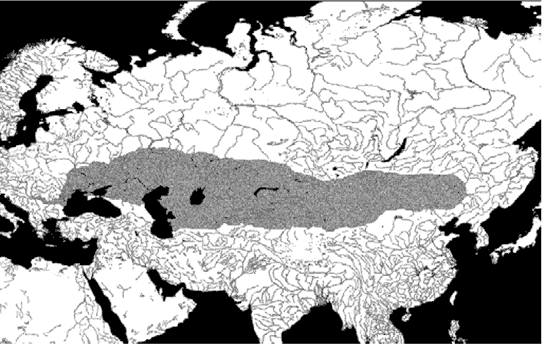 |
The depicted Steppe Belt corresponds to conditions from the 1st millennium BC to the present. During the preceeding 3–4 millenniums this belt was much more humid and warmer by 6°C, and the Steppe belt was located accordingly 1,000-2,000 km to the north, gradually shifting to the south in the 3rd-2nd millenniums BC. Accordingly, at the time of the Seima-Turbin phenomenon fast westward spread across Eurasia in the 2nd millennium BC, the present steppe belt was much more conductive for agriculture then it is today, and the spread took place in the steppes further north from the present steppe belt. In the second half of the 2nd millennium BC the steppe animal husbandry nomads extended their range to Gansu, Ordos, Wei valley, and eastern Shanxi, which by that time underwent aridization and became suitable for animal husbandry. That expansion is missing from the posted V.Chernykh's map. |
| Fig.2 The 5th millennium BC Balkan-Carpatian Metallurgical Province | |
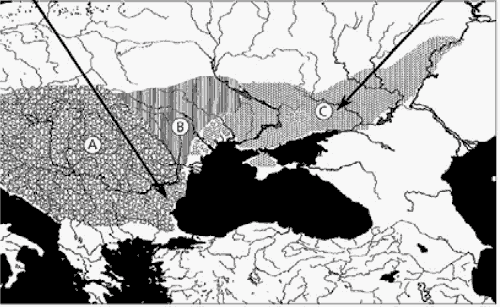 |
A - central block of cultures; |
| Fig. 3-1 The 4th millennium BC. Early phase of Circum-Pontic Metallurgical Province | |
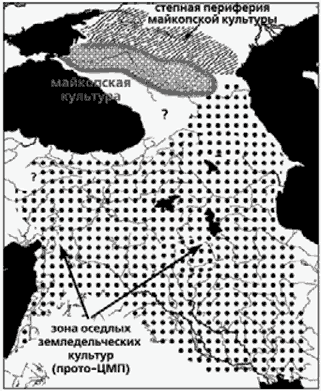 |
Hashed - Steppe periphery of the Maikop Culture |
| Fig. 3-2. 27th-22th cc. BC. Second phase of Circum-Pontic Metallurgical Province Pit Grave Kurgan Culture (western shading) expansion to Afanasiev Kurgan Culture (eastern shading) The area in-between 60°E and 80°E (dashed arrow) is awaiting its time |
|
 |
|
| Fig. 7 Mid 3rd millennium BC. Seima-Turbin transcultural phenomenon A phase in forming Eurasian Metallurgical Province. Two opposing waves of dispersal of cultural entities. Abashev Culture is a 3rd millennium BC blend of Afanasiev Pit Grave Kurgan and Circum-Pontic Pit Grave Kurgan Cultures |
|
|
Westward spread of Seima-Turbin Afanasiev Culture. |
Eastward spread of Pit Grave Kurgan Culture |
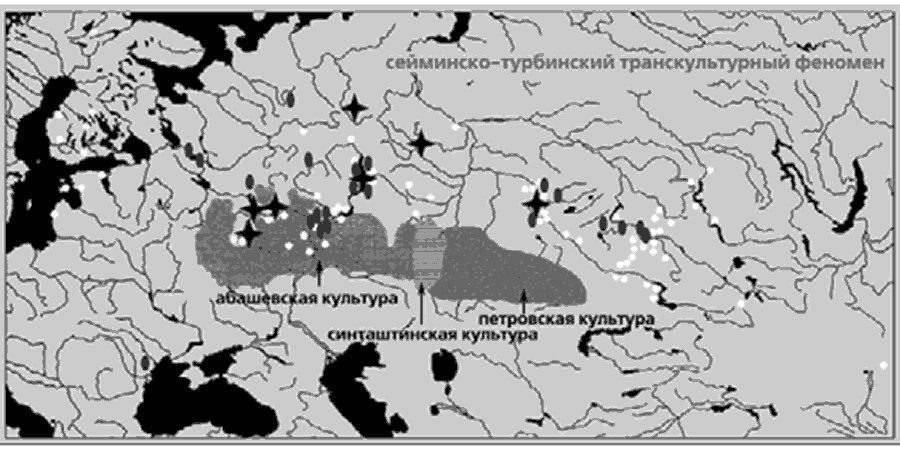 |
|
| Fig. 6. 18th/17th - 15th/14 cc. BC. Euro-Asian Metallurgical Province (EAMÏ) bordering on East Asian
Metallurgical Province (BAMÏ) Combined extent 6,000 km, combined territory 16-17 million km2 (shown on Fig.1) |
|
|
EAMÏ = EAMP - Euro-Asian Metallurgical Province |
BAMÏ = BAMP - East Asian Metallurgical Province |
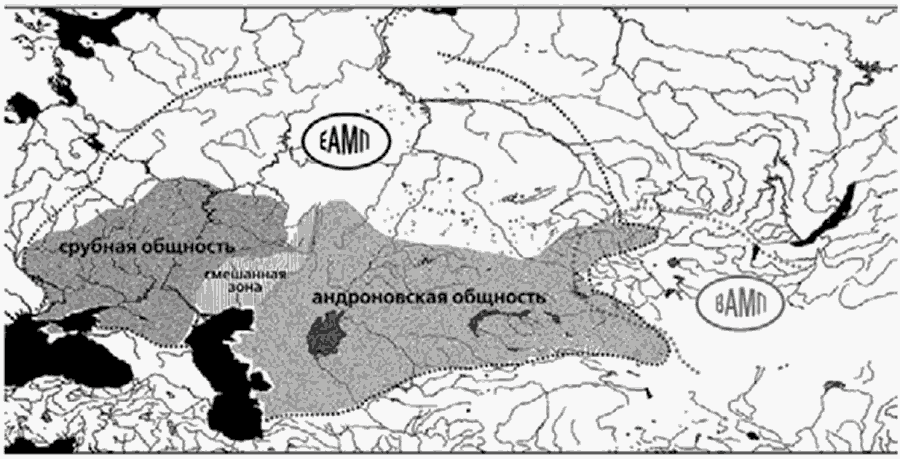 |
|
| Fig. 9. Spread of Karasuk Culture 22th - 18th/17th cc. BC. Spread of Karasuk Culture to Europe. 14th/13th - 8th cc. BC. Spread of Karasuk Culture to China |
|
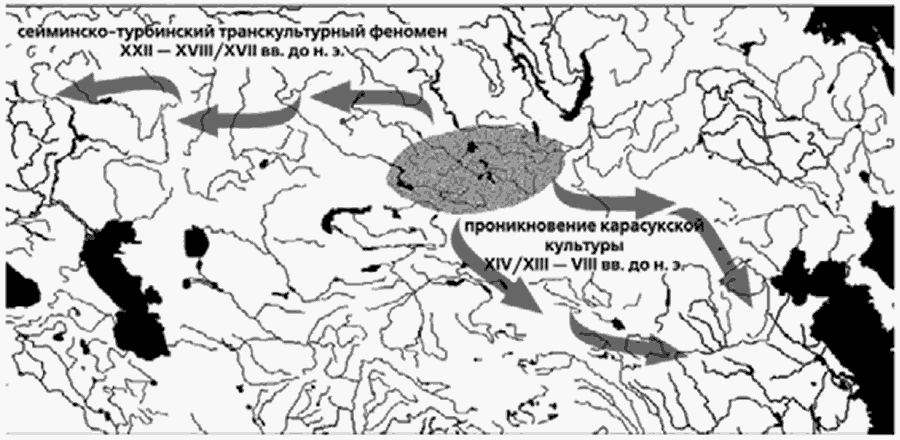 |
|
